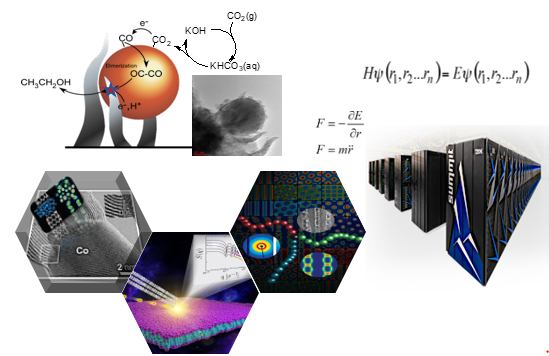Video Article Open Access
Understanding the Materials and Chemical World, Atom-by-Atom
Bobby G. Sumpter*, Jan-Michael Carrillo, David Lingerfelt
Center for Nanophase Materials Sciences, Oak Ridge National Laboratory, Oak Ridge, Tennessee, USA
Vid. Proc. Adv. Mater., Volume 3, Article ID 2210350 (2022)
DOI: 10.5185/vpoam.2022.10350
Publication Date (Web): 04 Apr 2023
Copyright © IAAM
Graphical Abstract

Abstract
Recent advances in computational algorithms, including machine learning approaches along with computer capacities that are orders of magnitude larger and faster, have enabled extreme-scale simulations and deep data analytics of materials properties and processes starting with nothing but the identity of the atomic species and the basic principles of quantum and statistical mechanics and thermodynamics. At the same time, advances in precision synthesis and nanoscale imaging, spectroscopy and scattering/diffraction have provided tremendous capabilities for experimentally investigating materials structural, dynamical, and functional characteristics. This powerful confluence of capabilities/advances and the information bound in large volumes of high-quality data, offer new opportunities for advancing materials and chemical sciences. To this end, we seek to decode the atomistic origins of the physicochemical processes that control the structure, morphologies and macroscopic physical, mechanical, electrical, and transport properties of materials by using an integrated approach where theory, modelling, and simulation work in concert with precision synthesis, advanced experimental characterization, and device measurements. In this talk I will present results obtained for materials that target applications for energy storage, energy conversion, information technologies, and lightweight functional and structural materials. I will further demonstrate how focused beam-matter interactions might be used to achieve directed control of atoms and thus deliver “defects and disorder by design” in materials. One of the underlying mechanisms for such beam-induced transformations is found to be due to accessing excited state pathways that are more facile than those on the ground state, underscoring the importance of detailed theoretical developments for such processes.
Keywords
Computational nanoscience, soft matter, functional materials, data analytics.
Acknowledgement
This work was performed at the Center for Nanophase Materials Sciences, a US Department of Energy Office of Science User Facility operated at Oak Ridge National Laboratory.
References
- S. Kalinin, B. G. Sumpter, R. Archibald, Big-Deep-Smart Data in Imaging for Guiding Materials Design, Nature Materials, 2015, 14, 973-980.
- D.B Lingerfelt, T. Yu, A. Yoshimura, P. Ganesh, J. Jakowski, B.G Sumpter, Nonadiabatic effects on defect diffusion in silicon-doped nanographenes, Nano. Lett., 2020, 21, 236-242.
- A. Yoshimura, J. Giedt, D.B Lingerfelt, J. Jakowski, P. Ganesh, T. Yu, B.G Sumpter, V. Meuniier, Quantum theory of electronic excitation and sputtering by transmission electron microscopy, Nanoscale (2022). DOI: 10.1039/d2nr01018f
- A. Ghosh, M. Ziatdinov, O. Dyck, B.G. Sumpter, S.V. Kalinin, Bridging microscopy with molecular dynamics and quantum simulations: an atomAI based pipeline, npj Comp. Mater., 2022, 8, 74.
- S.V. Kalinin, M. Ziatdinov, J. Hinkle, S. Jesse, A. Ghosh, K.P. Kelley, A.R. Lupini, B.G. Sumpter, R.K. Vasudevan, Automated and Autonomous Experiments in Electron and Scanning Probe Microscopy, ACS Nano, 2021, 15, 12604.
Biography
Bobby G. Sumpter received his Bachelor of Science in Chemistry from Southwestern Oklahoma State University (1983) and a Ph.D. in Physical Chemistry from Oklahoma State University in 1987. Following postdoctoral studies in Chemical Physics at Cornell University and in Polymer Chemistry at the University of Tennessee, Bobby joined the Chemistry Division at Oak Ridge National Laboratory in the Polymer Science group. He is currently the section head for Theory and Computation at the Center for Nanophase Materials Sciences (CNMS) and was the previous group leader for the Computational Chemical and Materials Sciences group, director of the Nanomaterials Theory Institute, and interim group leader for Macromolecular Nanomaterials at Oak Ridge National Laboratory alongside being the deputy director for the CNMS from 2014-2020. Dr Sumpter’s research is focused on the fundamental understanding of nanoscale self-assembly processes, interfacial interactions and dynamics, structure, transport, and dynamics of molecular-based materials, including multicomponent polymers and composites, and the physical, chemical, mechanical, and electronic properties of nanostructured materials. His research groups pursue forefront nanoscience using high-performance computing at scale alongside rational synthesis and materials characterization.
Video Proceedings of Advanced Materials

Upcoming Congress



